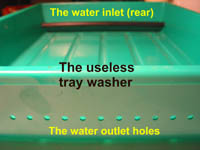Some
Information
about B&W Darkroom Work
This
pages was visited
 times
times
Photographic links
collection
Go to other interesting
Link Collections
Digital Truth
PhotoSource
( Brilliant collection of
themes and links)
Photographic utilities
Some results about research on the
| Ilford film washing
procedure |
The method works, however
| I recommend to use more
water if
there are 2 films in a tank. |
Download an article (8
Pages) with a detailed report about measurements of film washing
kinetics for several film types here and modify your procedure:
Current Version: 1.07 from
12 FEB 05, including now advice for print washing as below.
The article as .pdf file for downloading (Acrobat Reader
4.01 or higher required)
The article as .pdf file for downloading , printer
friendly, 2 Pages per sheet (Acrobat Reader 4.01 or higher required)
There is an interesting
and supporting comment af Marc Torzynski about this paper at another
place
>>Top
Washing prints:
(Same text is now included in pdf-file above about film washing)
II've been asked frequently what are my recommendations for washing
prints?
Here they are:
Fibre paper:
I follow the recommendation of AGFA: a bath of 2% Potassiumcarbonat is
used to open the fibres of the paper. Then my prints are washed in a
Kaiser tray where the incoming water is guided in a way that the water
together with the prints is continuously moved. After some time (10 -
15 min) I catch a print (18x24cm), hold it on one corner, wait until
the continuous water stream at the opposite edge turn to droplets, and
catch now the water for a potassium permanganate test as depicted in
above. In case no colour change is observed a give additional 10
minutes, if colour is changing, I repeat the test every 5 minutes until
colour change does not occur. Since I follow this procedure I haven't
found any problems with my prints even when they are exposed to
daylight for years.
RC-paper:
RC-Paper is too stiff to be washed together with fibre based paper. A
few sheets RC paper obstruct the movement in the tray completely.
 So I acquired a
special RC paper washer: A usual 30 x 40 cm tray, with
a tube at the one end, where several small holes distribute water into
the tray, and a row of holes in the tray at the other end as water
outlet. After a while I found that the amount a water spilled was
large, compared with the amount of water used per surface area of a
film. And this amount of water should be even less. because the
thickness of a RC paper emulsion is much less than of a film emulsion.
So I acquired a
special RC paper washer: A usual 30 x 40 cm tray, with
a tube at the one end, where several small holes distribute water into
the tray, and a row of holes in the tray at the other end as water
outlet. After a while I found that the amount a water spilled was
large, compared with the amount of water used per surface area of a
film. And this amount of water should be even less. because the
thickness of a RC paper emulsion is much less than of a film emulsion.
To check for small water supply (2 l/min) the movement and the
distribution of the water in the tray I throwed some Potassium
permanganate crystals into the water. I saw that at these low speed the
flow was just at the surface of the water in the tray, but at the
bottom,
where usually the print are located when washed, practically no water
movement
occurs. So this tray used as a print washer is badly designed and
useless
, because it fails completely its task: To provide as much fresh water
to the print as possible.
Today, as a conlusion, I wash my RC prints completely separate
from the fibre prints. When I start to wash them, each print is
individually flushed under running fresh water, which is running quite
slow (app. 0.2 - 0.3 l/min) just to remove the water loaded with hypo.
Then the prints are collected in a tray with fresh water and stacked
one above the other. For this I use a 18 x 24 cm tray with app. 1 l
water in. After a while
(app 30s) I start the same procedure, i.e. each sheet is hold
individually under slow running fresh water and put into another tray
with fresh water. The main principle is to follow what I have found for
film washing: reduce the amount of take over as much as possible .
Before I transfer the last sheet into the next tray I examine it with
the Potassium permanganate test as depicted above. As long as I
can observe a colour change I proceed. When the colour change is no
longer visible, I give two additional wash batches. It is astonishing
how small the number of batches is: for 20 18x24cm prints usually 4-5
batches are sufficient.
After all, my recommendation is to check the efficiency of washing and
control it as described. All other rules (apply exact times and
temperatures, specific agitation, and what ever...) do not
work reliable.
>>Top
Do you measure
temperatures and believe you measure correctly? Then read the article
about temperature measurement:
Bauanleitung für
Präzisionswaage für
Entwickleransatz für € 5.-
(Sorry, currently only in
German, an instruction how to build a precision scale for weighing
chemicals for photograhic purposes (Investment: € 5.- ):
>>Top
Return to Homepage
 times
times times
times